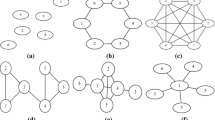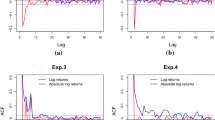Abstract
Traditional cheap-talk game model with homogeneous information sources provided a conclusion that dishonest information sources will not be identified if he changes strategy stochastically. In this paper, the authors incorporate different information diffusion networks and heterogeneous information sources into an agent-based artificial stock market. The obtained results are different with traditional results that identification ability of uninformed agents has been highly improved with diffusion networks and heterogeneous information sources. Additionally, the authors find uninformed agents can improve identification ability only if there exists a sufficient number of heterogeneous information sources in stock market.
Similar content being viewed by others
References
Kyle A S, Continuous auctions and insider trading, Econometrica: Journal of the Econometric Society, 1985, 53(6): 1315–1335.
Easley D and O’hara M, Information and the cost of capital, Journal of Finance, 2004, 59(4): 1553–1583.
Banerjee A V, A simple model of herd behavior, Quarterly Journal of Economics, 1992, 107(3): 797–817.
Alevy J E, Haigh M S, and List J A, Information cascades: Evidence from a field experiment with financial market professionals, Journal of Finance, 2007, 62(1): 151–180.
Benabou R and Laroque G, Using privileged information to manipulate markets: Insiders, gurus, and credibility, Quarterly Journal of Economics, 1992, 107(3): 921–958.
Van Bommel J, Rumors, Journal of Finance, 2003, 58(4): 1499–1520.
Chen Y, Perturbed communication games with honest senders and naive receivers, Journal of Economic Theory, 2011, 146(2): 401–424.
Crawford V P and Sobel J, Strategic information transmission, Econometrica, 1982, 50(6): 1431–1451.
Crawford V P, Lying for strategic advantage: Rational and boundedly rational misrepresentation of intentions, American Economic Review, 2003, 93(1): 133–149.
Liu Q, Information acquisition and reputation dynamics, Review of Economic Studies, 2011, 78(4): 1400–1425.
Kartik N, Ottaviani M, and Squintani F, Credulity, lies, and costly talk, Journal of Economic Theory, 2007, 134(1): 93–116.
Kartik N, Strategic communication with lying costs, Review of Economic Studies, 2009, 76(4): 1359–1395.
Davies P L and Canes M, Stock prices and the publication of second-hand information, Journal of Business, 1978, 51(1): 43–56.
Liu P, Smith S D, and Syed A A, Stock price reactions to the Wall Street Journal’s securities recommendations, Journal of Financial and Quantitative Analysis, 1990, 25(3): 399–410.
Fang L and Peress J, Media coverage and the cross-section of stock returns, Journal of Finance, 2009, 64(5): 2023–2052.
Klumpp T, Communication in financial markets with several informed traders, Economic Theory, 2007, 33(3): 437–456.
Becker B and Milbourn T, How did increased competition affect credit ratings?, Journal of Financial Economics, 2011, 101(3): 493–514.
Markose S, Alentorn A, and Krause A, Dynamic learning, herding and guru effects in networks, Economics Department Working Paper, University of Essex, 2004, No. 582.
Tedeschi G, Iori G, and Gallegati M, Herding effects in order driven markets: The rise and fall of gurus, Journal of Economic Behavior and Organization, 2012, 81(1): 82–96.
Hoffmann A O I, Jager W, and Eije J H V, Social simulation of stock markets: Taking it to the next level, Journal of Artificial Societies and Social Simulation, 2007, 10(2): 7.
Ponta L, Pastore S, and Cincotti S, Information-based multi-assets artificial stock market with heterogeneous agents, Nonlinear Analysis: Real World Applications, 2011, 12(2): 1235–1242.
Chen S H and Yeh C H, Evolving traders and the business school with genetic programming: A new architecture of the agent-based artificial stock market, Journal of Economic Dynamics and Control, 2001, 25(3–4): 363–394.
Arthur WB, Holland J H, LeBaron B, Palmer R, and Tayler P, MAsset pricing under endogenous expectations in an artificial stock market, The Economy as an Evolving Complex System II, Addison-Wesley, 1997, 15–44.
Watts D J and Strogatz S H, Collective dynamics of “small-world” networks, Nature, 1998, 393(6684): 440–442.
Börgers T and Sarin R, Naive reinforcement learning with endogenous aspirations, International Economic Review, 2000, 41(4): 921–950.
Author information
Authors and Affiliations
Corresponding author
Additional information
This research was supported by the National Natural Science Foundation of China under Grant Nos. 71131007, 71271144, and 71271145, the New Century Excellent Talents Supporting Program by Ministry of Education under Grant No. NECT-10-0626, the Innovative Research Team in University Supporting Program by Ministry of Education under Grant No. IRT 1208.
This paper was recommended for publication by Editor WANG Shouyang.
Rights and permissions
About this article
Cite this article
Feng, X., Zhang, W., Zhang, Y. et al. Information identification in different networks with heterogeneous information sources. J Syst Sci Complex 27, 92–116 (2014). https://doi.org/10.1007/s11424-014-3297-0
Received:
Revised:
Published:
Issue Date:
DOI: https://doi.org/10.1007/s11424-014-3297-0




